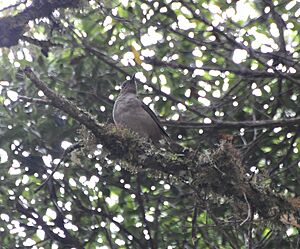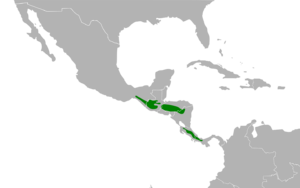Mountain thrush facts for kids
Quick facts for kids Mountain thrush |
|
|---|---|
 |
|
| Conservation status | |
| Scientific classification | |
| Genus: |
Turdus
|
| Species: |
plebejus
|
 |
|
The mountain thrush (scientific name: Turdus plebejus) is a type of large thrush bird. You can find it living in Central America. People used to call it the mountain robin. Sometimes, it's also called the American mountain thrush to help tell it apart from a similar bird, the Abyssinian thrush, which lives in Africa.
What Does It Look Like?
The mountain thrush looks a lot like other thrushes. It is about 23–26 cm (9.1–10.2 in) long. That's about the length of a ruler! It usually weighs around 86 g (3.0 oz).
Adult mountain thrushes are a dull olive-brown color. They have faint white lines on their throat. Their beak is black, and their legs are dark brown. Young mountain thrushes look similar to adults. However, they have light orange or buff streaks on their head and back. They also have dark spots on their belly.
Two other birds that look a bit like the mountain thrush live in the same areas. The sooty thrush is darker and has an orange beak, eye ring, and legs. The clay-colored thrush is much lighter in color and has a yellow beak.
Scientists have found three slightly different types of mountain thrushes. These types live in different parts of Central America. They have small differences in their feather colors.
Where Does It Live?
The mountain thrush lives in tall mountain forests. It also likes open areas next to woodlands. You can find it in the highlands from southern Mexico all the way to western Panama.
This bird prefers forests with oak trees. It especially likes trees that have many epiphytes (plants that grow on other plants) and mosses. They usually live at high altitudes, from about 1,800 m (5,900 ft) up to the tree line. During the wet season, they might fly down to lower areas, sometimes as low as 900 m (3,000 ft).
How Does It Behave?
The mountain thrush acts like other thrushes. It looks for food on large tree branches or on the ground. When it's not breeding, it often forages in groups. It moves by hopping and dashing, stopping often to look around. It turns over fallen leaves to find small fruits, insects, and spiders to eat.
Reproduction
The mountain thrush builds a large, cup-shaped nest. It uses grass or small roots to make the nest. The nest is usually hidden among epiphytes on a tree branch. It can be anywhere from 3–12 m (9.8–39.4 ft) above the ground.
The female bird lays 2 to 3 eggs. The eggs are a plain greenish-blue color. She lays her eggs between March and June. When it's breeding season, the male sings a special song. It sounds like a mechanical "chip chip cher chip chip cher cher." Its call is a high "seee" or "whip."


